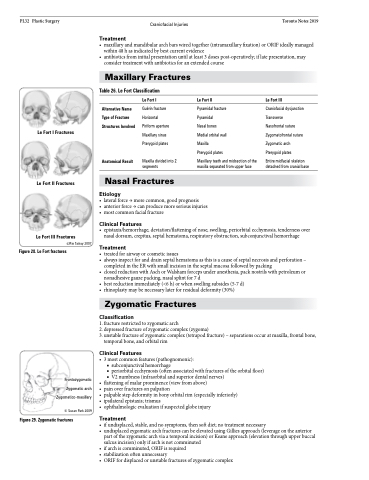Page 1154 - TNFlipTest
P. 1154
PL32 Plastic Surgery
Craniofacial Injuries Toronto Notes 2019
Treatment
• maxillaryandmandibulararchbarswiredtogether(intramaxillaryfixation)orORIFideallymanaged within 48 h as indicated by best current evidence
• antibioticsfrominitialpresentationuntilatleast3dosespost-operatively;iflatepresentation,may consider treatment with antibiotics for an extended course
Maxillary Fractures
Table 26. Le Fort Classification
Le Fort I Fractures
Le Fort II Fractures
Le Fort III Fractures Figure 28. Le Fort fractures
Alternative Name Type of Fracture Structures Involved
Anatomical Result
Le Fort I
Guérin fracture Horizontal Piriform aperture Maxillary sinus Pterygoid plates
Maxilla divided into 2 segments
Le Fort II
Pyramidal fracture Pyramidal
Nasal bones Medial orbital wall Maxilla
Pterygoid plates
Maxillary teeth and midsection of the maxilla separated from upper face
Le Fort III
Craniofacial dysjunction Transverse
Nasofrontal suture Zygomatofrontal suture Zygomatic arch Pterygoid plates
Entire midfacial skeleton detached from cranial base
Nasal Fractures
Etiology
Frontozygomatic Zygomatic arch Zygomatico-maxillary
© Susan Park 2009
Figure 29. Zygomatic fractures
• epistaxis/hemorrhage,deviation/flatteningofnose,swelling,periorbitalecchymosis,tendernessover nasal dorsum, crepitus, septal hematoma, respiratory obstruction, subconjunctival hemorrhage
Treatment
• treatedforairwayorcosmeticissues
• alwaysinspectforanddrainseptalhematomaasthisisacauseofseptalnecrosisandperforation–
completed in the ER with small incision in the septal mucosa followed by packing
• closedreductionwithAschorWalshamforcepsunderanesthesia,packnostrilswithpetroleumor
nonadhesive gauze packing, nasal splint for 7 d
• bestreductionimmediately(<6h)orwhenswellingsubsides(5-7d)
• rhinoplastymaybenecessarylaterforresidualdeformity(30%)
Zygomatic Fractures
Classification
1. fracture restricted to zygomatic arch
2. depressed fracture of zygomatic complex (zygoma)
3. unstable fracture of zygomatic complex (tetrapod fracture) – separations occur at maxilla, frontal bone,
temporal bone, and orbital rim
Clinical Features
• 3mostcommonfeatures(pathognomonic):
■ subconjunctival hemorrhage
■ periorbital ecchymosis (often associated with fractures of the orbital floor) ■ V2 numbness (infraorbital and superior dental nerves)
• flatteningofmalarprominence(viewfromabove)
• painoverfracturesonpalpation
• palpablestepdeformityinbonyorbitalrim(especiallyinferiorly) • ipsilateralepistaxis;trismus
• ophthalmologicevaluationifsuspectedglobeinjury
Treatment
• ifundisplaced,stable,andnosymptoms,thensoftdiet;notreatmentnecessary
• undisplacedzygomaticarchfracturescanbeelevatedusingGilliesapproach(leverageontheanterior
part of the zygomatic arch via a temporal incision) or Keane approach (elevation through upper buccal
sulcus incision) only if arch is not comminuted
• ifarchiscomminuted,ORIFisrequired
• stabilization often unnecessary
• ORIFfordisplacedorunstablefracturesofzygomaticcomplex
• lateralforce→morecommon,goodprognosis
• anteriorforce→canproducemoreseriousinjuries • mostcommonfacialfracture
Clinical Features
©Rio Sakay 2007


